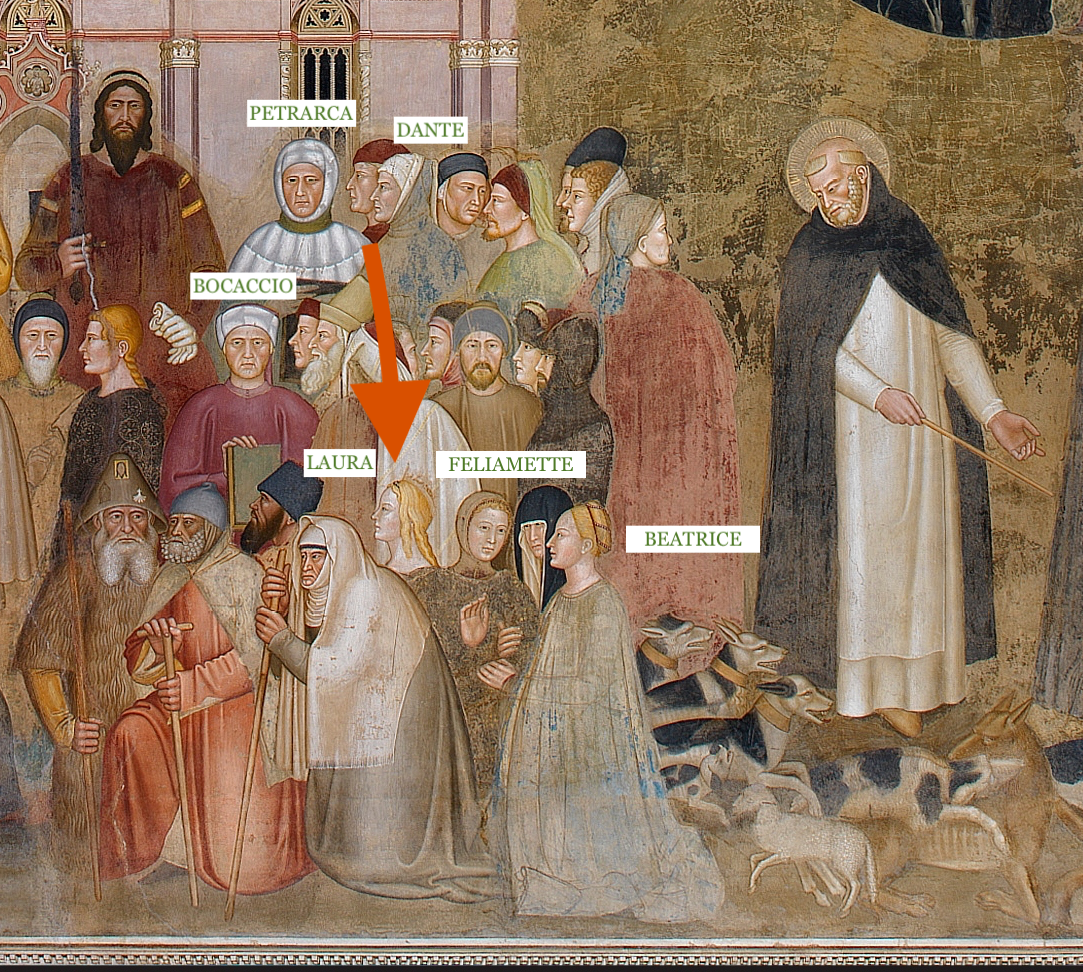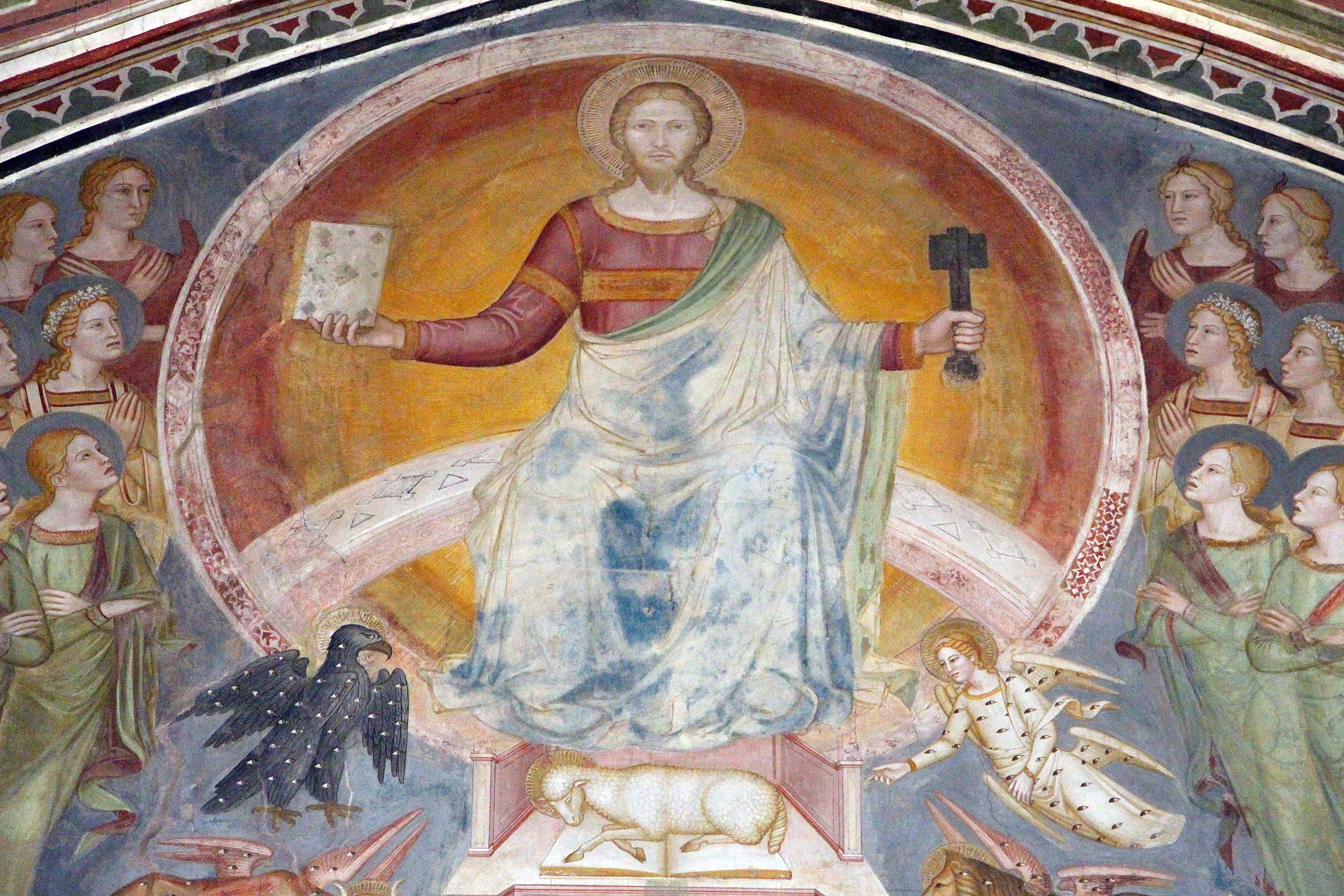PETRARCA & LAURA
Petrarca als luitspeler en gitarist.
Filippo Villani Petrarca’s tijdgenoot en biograaf schrijft dat Petrarca bewonderenswaardig Lira speelt (“Doctus insuper lyra mire crevit”).
Lira is waarschijnlijk de Latijnse naam voor luit omdat in Petrarca’s testament een luit staat beschreven. Een Madonna eveneens.
Deze informatie is een reden onderzoek te doen naar Petrarca.
Dante had zijn Beatrice, Bocaccio zijn Feliamette en Petrarca had zijn Laura. Wel onbereikbare liefdes.
Sala Capitolare Florence - Andrea di Bonaiuto 1365-1367


Sala Capitolare Florence - Andrea di Bonaiuto 1365-1367
Petrarca’s Laura was niet het product van zijn verbeelding, maar heette Laure de Noves en was getrouwd met de Provençaalse edelman Hugo de Sade, die zij elf kinderen schonk. Petrarca zag haar voor het eerst op Goede Vrijdag (6 april) 1327 in de kerk van Sainte-Claire in Avignon. Zij was toen vermoedelijk negentien jaar, en in 1348 werd zij slachtoffer van de grote pestepidemie die meer dan een kwart van de Europese bevolking wegvaagde.
Onbereikbaarheid was het uitgangspunt van de hoofse liefde, zoals die door de troubadours werd bezongen. En deze vooral in de Provence tot bloei gekomen troubadourspoëzie was maatgevend voor de Italiaanse poëzie die zich vanaf het einde van de dertiende eeuw had ontwikkeld, de zogenoemde stil nuovo.
Nu de hoofdpersonen in het onderzoek:
Francesco Petrarca:
aanwezig in Avignon April 6th 1327 - 1330 en 1337 - 1340
Laura de Noves Avignon 1310 - 1348
Simone Martini aanwezig in Avignon 1339 - 1344
Simone Martini schilderde in deze periode voor Benedict XII (ca. 1334-1342) en raakte bevriend met Martini.
Giorgio Vasari (1511-1574) was schilder en architect en schrijft in Giorgio Vasari | Lives of the Most Eminent Painters Sculptors and Architects een hoofdstuk over Simone Martini (1285-1344) and Lippo Memmi (d. 1357):
(Simone Martini was getrouwd met de zuster van Lippo Memmi.)
Volgens Vasari schilderde Martini te Avignon het portret van Madonna Laura
Petrarca haalde Simone Martini aan in twee sonetten:
Per mirar Policleto a prova fiso
Con gli altri che ebber fama di quell' arte;
and the second:
Quando giunse a Simon 1' alto concetto
Ch' a mio nome gli pose in man lo stile.
Er zijn heel veel portretten van Laura geschilderd maar de afbeelding van Laura geschilderd door Andrea di Bonaiuto da Firenze of Andrea da Firenze (actief 1343 – 1377) zou wel eens de dichtst bij het origineel van Simone Martini kunnen zijn.

Martini is in 1344 overleden, zijn zwager Lippo Memmi in 1356
Andrea di Bonaiuto actief van 1343 Petrarca is in 1374 overleden. Het portret van Petrarca van Andrea di Bonaiuto in de Sala Capitolare zijn geschilderd tussen 1365 en 1367.
Andrea di Bonaiuto zou ook het portret van LAURA DE NOVES geschilderd door Simone Martini gezien kunnen hebben.
Sala Capitolare Florence
De kapittelzaal later omgevormd tot een kapel en de Cappellone degli Spagnoli of Spaanse Kapel genoemd. De naam is afgeleid van het feit dat de kapel ter beschikking werd gesteld aan Eleonora di Toledo (1522-1562), de Spaanse vrouw van Groothertog Cosimo, en werd gebruikt door de grote Spaanse gemeenschap in Florence.
De Spaanse Kapel geniet de meeste faam vanwege een indrukwekkende frescocyclus van Andrea di Bonaiuto. Wie de kapel binnentreedt, ziet als eerste de altaarmuur, met daarop fresco’s betreffende de Passie van Christus, de Kruisiging en de Afdaling in het Voorgeborchte. De fresco’s op de rechter muur verheerlijken de Dominicaanse Orde met een Allegorie van de Strijdbare en Zegevierende Kerk. De frescocyclus werd tussen 1365 en 1367 geschilderd.
De Dominicanen zijn op de rechter muur afgebeeld als whippets. Dit is een verwijzing naar de Latijnse woorden Domini Canes (de Honden van de Heer), een woordspeling op hun naam. De paus in het midden van het fresco zou Benedictus XI (1303-1304) kunnen zijn, die zelf een Dominicaan was. De linker muur heeft een fresco over de Triomf van Sint Thomas van Aquino, en op het plafond zien we de Wederopstanding, de Hemelvaart, de Bark van Petrus en Pinksteren.
Andrea di Bonaiuto da Firenze or Andrea da Firenze (active 1343 – 1377)
On 30 December 1365 painter Andrea di Firenze signed a contract for the decoration of the chapter house (known as the Spanish Chapel) of Santa Maria Novella in Florence.

On 30 December 1365 painter Andrea di Firenze signed a contract for the decoration of the chapter house (known as the Spanish Chapel) of Santa Maria Novella in Florence. The Chapter House is misleadingly known as Spanish Chapel, because of its use in the sixteenth century by the Spanish community in Florence.
According to the contract, he was to complete the chapel’s frescoes in two years, or less. During this period, Santa Maria Novella’s friars would allow the painter and his wife to live in a nearby house free of charge.
Although Andrea only started working on the frescoes in 1365, the decoration was actually conceived in 1355, when Florentine merchant Buonamico di Lapo donated the necessary sum to the monastery. The contemporary prior Fra’ Jacopo Passavanti, his successor Fra’ Zanobi Guasconi, or an expert committee at the monastery’s theological school chose the content of the frescoes, which glorify the Dominican order. Thus, main scenes are dedicated to the thirteenth-century saints Peter Martyr and Thomas Aquinas, both Dominican friars. Other frescoes represent episodes in the life of Jesus and the Apostles, for example the Crucifixion and Pentecost. The theological structure of the Church is also represented as Church Militant and Church Triumphant.
While Andrea is generally considered a minor painter among fourteenth-century Florentine artists, his work at the chapter house reveals great skill in organizing complex scenes without using the decorative bands typical of earlier painting. Moreover, he added realism and appeal to the composition by giving individual features to each of the innumerable characters he depicted. The Chapel’s decoration was indeed considered a success by his contemporaries, leading to important commissions at the Camposanto (graveyard) of Pisa, where he worked until his death in 1379.
Andrea di Bonaiuto da Firenze was a member of the Physicians' Guild in Florence (to which painters belonged) in 1346.
He lived in the parish of Santa Maria Novella and seems to have been influenced by the work of Nardo di Cione, with whom he may have trained.
He also undertook fresco decorations for the church’s chapter house and a full-scale cartoon for the stained-glass window decoration of the façade is also attributed to him.
The earliest paintings that can be attributed to him suggest that he must have formed a close association with the workshop of Andrea di Cione. The small portable triptych of the Virgin and Child with Saints and Angels shows the influence of Maso di Banco and of the painter of the Strozzi Chapel frescoes in the Chiostrino dei Morti, S Maria Novella, Florence.
Andrea di Bonaiuto left Florence in 1355 to work in Pisa, where he stayed for roughly ten years. When he returned to Florence, he received the most important painting commission of the 1360s. From 1365 to 1367 he was engaged in painting frescoes in the Chapter House in Santa MARIA NOVELLA in Florence.
The frescoes were commissioned by Buonamico Guidalotti.
Probably as a result of this commission, Andrea was simultaneously appointed to a committee planning the design for the dome of the cathedral of Florence. He served on this board for two years, completing his term in 1367. He then spent a brief time in Orvieto before returning to Florence, where he painted a panel of Saint Luke for the hospital of Santa Maria Nuova in 1374. In 1377, he accepted a commission to paint an altarpiece in Pisa, and then stayed in Pisa long enough to execute a fresco (now damaged) in the Camposanto. He died in 1379, leaving only a paltry estate for his widow and his one child, Bartolomeo.
The choice of Andrea di Bonaiuto as the painter of the Spanish Chapel suggests that he was one of the most important artists of the day is appointment to the committee planning the dome of the cathedral indicates that he was highly respected by Florentine civic leaders. There can be no doubt that Andrea was recognized as a major figure in his native city during this period, and his works in Santa Maria Novella are one of the great decorative programs of the late Trecento. But the paucity of signed or dated paintings leaves us with only a meager understanding of the artist’s abilities, interests, and influences.
Although he was acquainted with Giotto's innovations in modelling and spatial depth, Andrea was also strongly influenced by the linear, hieratic art of his Florentine contemporary Andrea Orcagna, and most of his fresco works display the rigid compositions and immobile faces associated with the Byzantine tradition. Andrea is last recorded in 1377 working on frescoes of the Life of St. Ranieri in the Campo Santo at Pisa, and the three upper panels of this mural project are attributed to him.
Sala Capitolare Florence - Andrea di Bonaiuto 1365-1367

Sala Capitolare Florence - Andrea di Bonaiuto 1365-1367

Sala Capitolare Florence - Andrea di Bonaiuto 1365-1367

Sala Capitolare Florence - Andrea di Bonaiuto 1365-1367

Sala Capitolare Florence - Andrea di Bonaiuto 1365-1367

Sala Capitolare Florence - Andrea di Bonaiuto 1365-1367

Sala Capitolare Florence - Andrea di Bonaiuto 1365-1367

Sala Capitolare Florence - Andrea di Bonaiuto 1365-1367

Sala Capitolare Florence - Andrea di Bonaiuto 1365-1367

Sala Capitolare Florence - Andrea di Bonaiuto 1365-1367

Sala Capitolare Florence - Andrea di Bonaiuto 1365-1367

 Foundation Musick's Monument
Foundation Musick's Monument